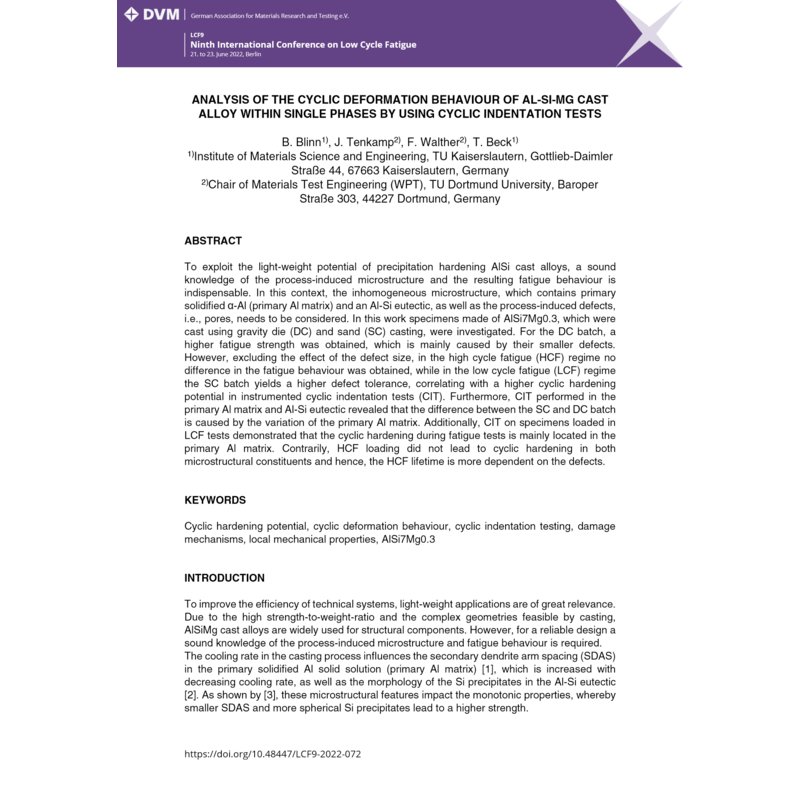- Nur online erhältlich



Because of increasing demands regarding the efficiency and energy consumption, light-weight solutions have a high relevance for the design of components. Therefore, Al cast alloys, which offer a low density, a high strength-to-weight-ratio and complex geometries, are used increasingly. However, to exploit their whole potential in application, a sound knowledge about their fatigue behavior is indispensable.
In this work, the cyclic deformation behavior of Al cast alloy AlSi7Mg0.3 (T6 heat-treated) was investigated. The specimens were produced by using die casting (DC), leading to small dendrite arm spacing (DAS) and spherical Si particles, as well as sand casting (SC), which results in large DAS and flake-shaped Si particles in Al-Si eutectic.
The fatigue tests show…

Datenschutzbedingungen (bearbeiten im Modul "Kundenvorteile")

Lieferbedingungen (bearbeiten im Modul "Kundenvorteile")

Rücksendebedingungen (bearbeiten im Modul "Kundenvorteile")
Because of increasing demands regarding the efficiency and energy consumption, light-weight solutions have a high relevance for the design of components. Therefore, Al cast alloys, which offer a low density, a high strength-to-weight-ratio and complex geometries, are used increasingly. However, to exploit their whole potential in application, a sound knowledge about their fatigue behavior is indispensable.
In this work, the cyclic deformation behavior of Al cast alloy AlSi7Mg0.3 (T6 heat-treated) was investigated. The specimens were produced by using die casting (DC), leading to small dendrite arm spacing (DAS) and spherical Si particles, as well as sand casting (SC), which results in large DAS and flake-shaped Si particles in Al-Si eutectic.
The fatigue tests show a crack propagation along stress-concentrating Si particles and a higher damage tolerance of SC compared to DC specimens. To elaborate the differences in damage tolerance, cyclic indentation tests (CIT) were performed to determine the materials cyclic hardening potential, which correlates with damage tolerance and is represented by cyclic hardening exponentCHT |eII|. In addition to CIT with maximum indentation force |Fmax| = 1000 mN, enabling an integral measurement of heterogenous microstructure, CIT with |Fmax| = 100 mN were performed locally in Al matrix and Al-Si eutectic to analyze the cyclic deformation behavior within the single phases (see Fig. 1).
In correlation to the fatigue tests, the CIT with bigger |Fmax| show higher cyclic hardening potential (|eII|) for SC. For both variants, a significant decrease of |eII| can be observed after a fatigue test with σa = 220 MPa, which is caused by pronounced cyclic hardening during fatigue tests (see Fig. 2). Comparing the results obtained within the single phases, for both variants only in Al matrix a decrease of cyclic hardening potential can be observed. Consequently, the cyclic hardening is mainly located in Al matrix.
Furthermore, CIT were performed at a DC specimen loaded with σa = 120 MPa, showing no significant decrease of |eII| (see Fig. 2). Due to smaller σa, the plastic deformation is more localized at stress concentrating Si particles and thus, no cyclic hardening can be observed in the Al matrix, which corresponds with crack initiation at and propagation along Si particles.
As a summary, the present results demonstrate, that the CIT are a powerful means to analyze the cyclic deformation behavior locally, i.e. within single phases.